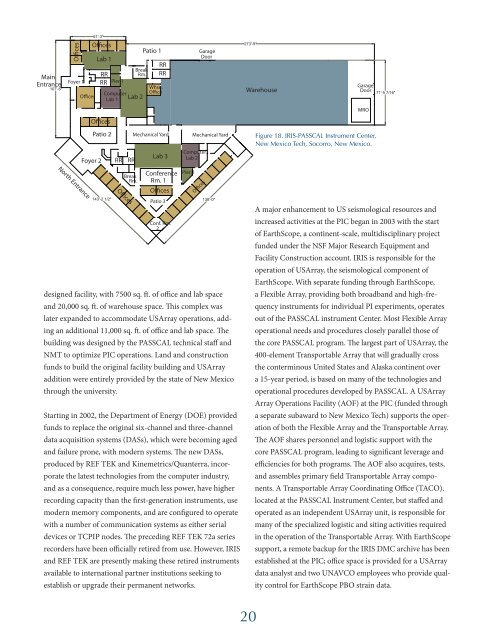Download 9.3 Mb pdf - IRIS
Download 9.3 Mb pdf - IRIS
Download 9.3 Mb pdf - IRIS
Create successful ePaper yourself
Turn your PDF publications into a flip-book with our unique Google optimized e-Paper software.
Main<br />
Entrance<br />
107'-6"<br />
Offices<br />
Foyer 1<br />
North Entrance<br />
Offices<br />
61'-3"<br />
Offices<br />
Lab 1<br />
RR<br />
RR Pier 1<br />
Computer<br />
Lab 1<br />
Offices<br />
Patio 2<br />
Foyer 2<br />
143'-2 1/2"<br />
RR<br />
Offices<br />
Lab 2<br />
RR<br />
Break<br />
Rm.<br />
Break<br />
Rm.<br />
Patio 1<br />
RR<br />
RR<br />
Whse.<br />
Office<br />
Mechanical Yard<br />
Lab 3<br />
Conference<br />
Rm. 1<br />
Offices<br />
Patio 3<br />
Conf. Rm.<br />
2<br />
Computer<br />
Lab 2<br />
Pier 2<br />
Garage<br />
Door<br />
Mechanical Yard<br />
Offices<br />
138'-0"<br />
designed facility, with 7500 sq. ft. of office and lab space<br />
and 20,000 sq. ft. of warehouse space. This complex was<br />
later expanded to accommodate USArray operations, adding<br />
an additional 11,000 sq. ft. of office and lab space. The<br />
building was designed by the PASSCAL technical staff and<br />
NMT to optimize PIC operations. Land and construction<br />
funds to build the original facility building and USArray<br />
addition were entirely provided by the state of New Mexico<br />
through the university.<br />
Starting in 2002, the Department of Energy (DOE) provided<br />
funds to replace the original six-channel and three-channel<br />
data acquisition systems (DASs), which were becoming aged<br />
and failure prone, with modern systems. The new DASs,<br />
produced by REF TEK and Kinemetrics/Quanterra, incorporate<br />
the latest technologies from the computer industry,<br />
and as a consequence, require much less power, have higher<br />
recording capacity than the first-generation instruments, use<br />
modern memory components, and are configured to operate<br />
with a number of communication systems as either serial<br />
devices or TCPIP nodes. The preceding REF TEK 72a series<br />
recorders have been officially retired from use. However, <strong>IRIS</strong><br />
and REF TEK are presently making these retired instruments<br />
available to international partner institutions seeking to<br />
establish or upgrade their permanent networks.<br />
273'-9"<br />
Warehouse<br />
Garage<br />
Door<br />
MRO<br />
Figure 18. <strong>IRIS</strong>-PASSCAL Instrument Center,<br />
New Mexico Tech, Socorro, New Mexico.<br />
71'-5 7/16"<br />
Office Space =<br />
1,146 sq. ft.<br />
Computer Lab Space = 1,316 sq. ft.<br />
Lab Space =<br />
3,724 sq. ft.<br />
Warehouse Space = 17,912 sq. ft.<br />
A major enhancement to US seismological resources and<br />
increased activities at the PIC began in 2003 with the start<br />
of EarthScope, a continent-scale, multidisciplinary project<br />
funded under the NSF Major Research Equipment and<br />
Facility Construction account. <strong>IRIS</strong> is responsible for the<br />
operation of USArray, the seismological component of<br />
EarthScope. With separate funding through EarthScope,<br />
a Flexible Array, providing both broadband and high-frequency<br />
instruments for individual PI experiments, operates<br />
out of the PASSCAL instrument Center. Most Flexible Array<br />
operational needs and procedures closely parallel those of<br />
the core PASSCAL program. The largest part of USArray, the<br />
400-element Transportable Array that will gradually cross<br />
the conterminous United States and Alaska continent over<br />
a 15-year period, is based on many of the technologies and<br />
operational procedures developed by PASSCAL. A USArray<br />
Array Operations Facility (AOF) at the PIC (funded through<br />
a separate subaward to New Mexico Tech) supports the operation<br />
of both the Flexible Array and the Transportable Array.<br />
The AOF shares personnel and logistic support with the<br />
core PASSCAL program, leading to significant leverage and<br />
efficiencies for both programs. The AOF also acquires, tests,<br />
and assembles primary field Transportable Array components.<br />
A Transportable Array Coordinating Office (TACO),<br />
located at the PASSCAL Instrument Center, but staffed and<br />
operated as an independent USArray unit, is responsible for<br />
many of the specialized logistic and siting activities required<br />
in the operation of the Transportable Array. With EarthScope<br />
support, a remote backup for the <strong>IRIS</strong> DMC archive has been<br />
established at the PIC; office space is provided for a USArray<br />
data analyst and two UNAVCO employees who provide quality<br />
control for EarthScope PBO strain data.<br />
20

















